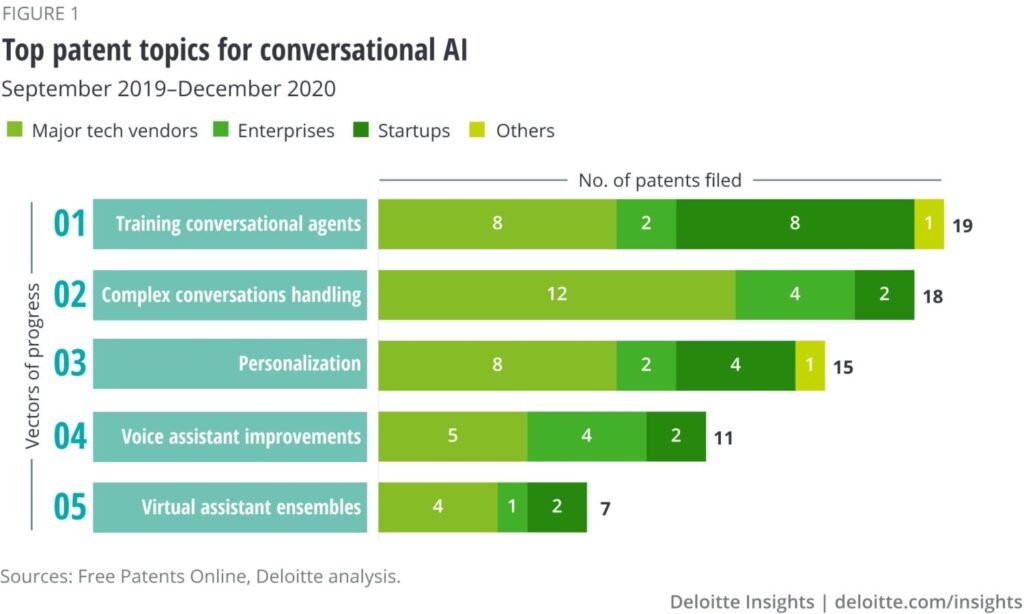Amplify Customer Experience in Retail with Conversational AI

Last updated on February 8, 2024
The Ecommerce industry has seen an impressive development in recent years.
Not only are online retailers enjoying massive revenue from their customers (expected to be over $6 trillion in 2022), but the platforms themselves are also becoming increasingly sophisticated.
Now, technologies such as AI and machine learning are driving highly personalized customer experiences. They can also be used for experience mapping, which is a detailed visualization of a customer’s experiences with your product or services over time. This is beneficial because it puts you in the customer’s shoes and helps you to better understand how customers feel at various touchpoints throughout the customer journey.
Naturally, this is setting a new benchmark for E-commerce stores, since customers are choosing to shop at only the best websites in the competitive space.
The question for online retailers is: how can we embrace this trend and deliver for our customers?
For many, the answer is found in conversational AI.
Are you new to the world of conversational AI, or are you an expert simply looking to brush up on your knowledge? Well, this article will cover everything you need to know; from the benefits of the tech to the drawbacks, as well as several real-life use cases to inspire you.
In This Article:
What is conversational AI and why is it important for customer experience in retail?
Conversational AI is a browser-based messaging service that connects customers with the platforms they use. Typically, you would see this in the form of a ‘Live Chat’ pop-up that provides automated responses to customer queries.
To go further, modern chatbots are now pre-empting the moments when customers require their assistance. For example, by only appearing at customer pain points, like a hesitation on a particular product page or at the checkout.
With conversational AI put into play, providing a great customer experience in retail becomes easier. For example, it elevates customer engagement, customer service efforts become more efficient, and it brings more personalized experiences.
So, to sum it up, conversational AI seeks to deliver a more pleasant shopping experience by providing customers with relevant information at the most crucial sales cycle stages.
How to amplify customer experience in retail with conversational AI
This section will cover how the top E-commerce companies implement their conversational AI strategies successfully.
Incorporate a digital sales agent
The most common feature of a conversational AI strategy is the use of a virtual sales agent.
This is essentially a software program that uses scripted rules and AI to provide human customers with relevant guidance. Normally, you will see this in the corner of the screen during the shopping process, such as on your website’s homepage.
You might expect this digital sales agent to provide links to useful resources on your website. Some common options include:
- About us
- Explore our products/services
- An FAQs section
- Your orders or shopping history
- Your last viewed item
- Customer support
- Help with delivery/payments
Provide voice-enabled search queries
Accessibility should be at the core of your conversational AI strategy.
For starters, your virtual sales agent should be a) visible and b) obvious as to its purpose. A simple message will do the trick, such as “Hey, I’m [chatbot name], may I help you with your shopping today?”
Another great idea to explore is offering a digital sales agent that is voice-enabled.
Ideally, this would allow for customer voice recognition, meaning that users may speak their request rather than type it. In turn, the virtual agent may respond with talk-back capability, allowing seamless B2C interaction. This may be especially useful for your young, elderly, or disabled customer demographic.
Beyond this, you should provide multiple language options so that your customers can use the service no matter where they are in the world.
Set up chatbots for a 24/7 contact center
Of course, you should also integrate conversational AI into your customer service strategy.
Your virtual sales agent is already well-equipped to deal with this. Firstly, the digital assistant should offer customer service in its welcome messages. E.g. “Ask me for help with…”
From here, your customers can directly ask questions and the AI can learn to recognize what is being asked of it. This allows for an automated response system where customers are given the correct information, rather than bogging down your human customer service reps with repetitive tasks.
Furthermore, your chatbot can be linked to any number of client portal solutions. This allows customers to track their inquiries on a self-service platform. Definitely provide an option for customers to reach a human rep (such as a text option “I want to speak to a human…”), as this will expedite the process and reduce frustration.
Drawbacks of conversational AI
All new technologies bring with them challenges and drawbacks. It’s useful to consider these in the context of your overall strategy.
Data privacy issues
A major concern for customers is the privacy of their data. For an AI to work effectively, it must gather data on customer behavior (e.g., their viewing history, purchase history, or browser cookies). However, this may overstep a boundary for some customers, who may feel like they are being spied on.
As such, it’s important to reassure your customers that your privacy policy is secure and transparent. You should communicate clearly how their data is protected, where it is being collected, and provide an option to delete data if they wish to do so.
Additionally, if your services involve integrating with platforms like Google, it’s crucial to inform customers about how they can delete data from Google as well. It may be a good idea to provide a link to change these options or to delete data, both from your service and from Google, inside your chatbot AI interface. This approach ensures that customers have full control over their personal information and enhances their trust in your services.
Lack of human empathy
While conversational AI is very sophisticated these days, there are some areas where it falls short of genuine human interaction.
The main shortfall is the lack of human empathy. Let’s not get ahead of ourselves—chatbots are emotionless and won’t understand the effect that their words have on your customers.
As such, human oversight and evaluation are absolutely necessary. You want your conversational AI to use broadly positive and empathetic language, even if it’s merely an illusion. This is especially important to maintain your customer lifecycle value. Consider how your chatbot should speak to customers at different stages of the sales process, like asking “How was your recent order?…” to a returning customer.
Additional tips include showing a human avatar next to the virtual agent to give the impression they are speaking with a real person. You should also provide an outlet for receiving feedback from your customer’s experience, such as a “How did I do?…” prompt.
Unidentified customer inputs and questions
Another concern is that AI chatbots are not always capable of understanding what is being asked of them.
Common hiccups include where a customer has made a spelling mistake, used incorrect grammar, or otherwise recorded their input incorrectly. It’s all too easy for the AI to get mixed up here and return the wrong answer, which may lead to a frustrating feedback loop for the customer.
As such, you need to make your AI chatbot intuitive. It should be simple to use and contain predefined statements in a list for your customers to choose from.
The benefits of conversation AI in Ecommerce
Now that we’ve covered the nitty-gritty stuff, we can talk more about why conversational AI is such a powerful tool.
Decreases the possibility of abandoned carts
As mentioned earlier, there are several pain points in the customer sales process.
The most significant of these comes at the checkout phase. This is natural, of course, as confirming the transaction is usually the point of most scrutiny from the customer. If they have any doubts or reservations, they will likely hold off on finalizing their order. As such, a tactically placed chatbot here will be well-equipped to convert your customers.
Addresses customer queries faster
Perhaps the most obvious benefit of conversational AI is its ability to drive faster customer interactions.
A chatbot can respond instantaneously, whereas a human must type. A chatbot can also speak to thousands of customers at once, whereas a human can only manage one at a time. This makes chatbot AI a highly effective option for delivering a basic customer service solution. You can use a ready-made AI prompt library to speed up your work.
When you consider how cheap some of these chatbot programs come, it’s easy to see their worth as some of the best apps for sales reps.
Easy order processing with chatbots
Beyond simply providing information or shortcuts around your website, a virtual assistant may also perform basic functions on the customer’s behalf.
For example, a customer may ask a chatbot to “Add 3 quesadillas to my basket to be delivered to home for 18:30”. The AI can then work out what the customer wants, and when/where they want it sent. Consequently, a pre-filled order may be created in a matter of seconds, saving your customer precious time.
Real-time order status updates
Another useful feature is for chatbot AIs to fetch personalized information on request.
A common example of this is recurring customers checking in on their delivery updates. Well, rather than navigating to this part of the website manually, a chatbot AI could navigate for the customer. It could present the information in an easy-to-read format, and tell them the basics such as whether it will be early, late, or running on time.
Lead generation
We usually think of conversational AI as assisting in the eCommerce conversion process. That is the point at which an attracted site visitor spends money to become a customer.
However, as chatbots become more sophisticated, they are now also being used for different roles in the customer lifecycle journey. Namely, for contacting prospective customer leads.
To give an example, imagine a small business that doesn’t have time to respond to all of its social media inquiries. That business may choose to implement a chatbot that replies to the questions and leads the prospect in the right direction. This would likely boost lead generation for the website’s sales funnel for relatively little expenditure.
Wrap-Up and Key Takeaways
To conclude, conversational AI is an innovative solution for driving positive customer experiences. For a low upfront cost, it relieves your customer service team of many arduous tasks. It makes it easier for customers to navigate your site, and can consequently boost customer conversion and loyalty.
Hopefully, by now, you have an idea of what features a good chatbot AI ought to include. As your expertise in conversational AI develops, you may choose to develop its application for business process software. For instance, using a chatbot for employee onboarding, time tracking, vacation requests, online invoicing, and much more.



